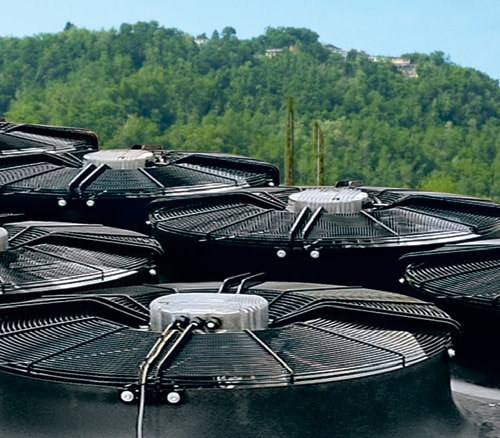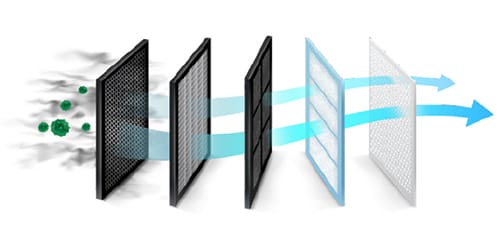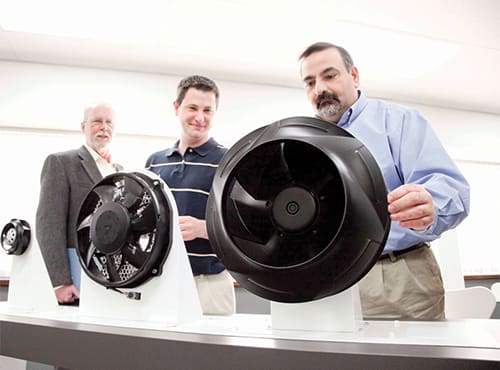
George Riker
Business Development Manager
ebm-papst
RS’s “Ask The Expert” series taps into the experience and expertise of key thought leaders and subject matter experts from more than 500 global suppliers we work closely with to bring customers solutions for their most challenging problems (and the daily ones, too).
Maintaining a high level of air quality, especially when COVID-19 still dominates the national conversation, is critical for any organization across the business landscape. In this article, we will discuss the components needed for an effective, efficient air purification system. For additional insight into the types of industrial and commercial equipment available on the market, we talked with George Riker, Business Development Manager at ebm-papst, who has more than 25 years of experience in the industry.
A Risk Worth Prioritizing
According to the Environmental Protection Agency (EPA), roughly 90% of the average American’s life happens indoors. In these spaces, the air is continuously recirculated, along with the many contaminants air can carry, such as carbon dioxide, tobacco smoke, pollen, dust, mold, viruses, bacteria, and other air pollutants. Recently, businesses have also had to deal with the continued public health fallout of the COVID-19 pandemic still impacting many parts of the world. With new, highly transmissible variants contributing to spikes in both hospitalizations and deaths the importance of effective commercial and industrial fans has never been so pronounced.

Regardless of industry, organizations should always mitigate environmental air quality risks for their employees and customers as much as possible. In the current environment, it is more of a priority than ever. Business leaders must have a baseline knowledge of the variables at play in the air quality control process and what resources and pieces of equipment are necessary to maintain and (when needed) replace to ensure the air in your facility is as safe as possible from COVID and other hazardous air contaminants.
The Elements of an Air Purification System
Air quality control is a relatively simple process but a critical one — and one that can easily be compromised if equipment is neglected. Essentially, indoor air is continuously circulated through some form of air purifier. There are a few different kinds of purifiers available, each with unique qualities, but they each conceptually have the same goal: to separate harmful contaminants from the air as it moves through the device.

The most common purification method uses an air filter, no different than most people routinely change in their homes. Filters, made of a net of synthetic fibers, are remarkably effective at capturing particles as small as viruses at an efficiency rate of 99.97%. These filters can also be made from compressed carbon, which is designed to capture pollutants such as smoke and cooking fumes instead of contaminated air particles. The drawback, however, is as contaminates accumulate within the filter, the more resistance it poses to the air circulating through it. If not replaced regularly, filters can eventually restrict airflow entirely due to particulate buildup.
As technology has advanced, other air purification options have also been introduced to the market. As opposed to “filtering” the circulated air, these options focus on eliminating the contaminants through the use of ultraviolet light or catalytic oxidation. Ultraviolet light can alter the structure of harmful molecules at the DNA level and prevent them from multiplying, while catalytic oxidation uses a combination of light and catalysts to convert pollutants into a harmless state. However, both of these options still necessitate being paired with traditional air filters for maximum protection.
Having the Right Fan
Despite the type of equipment used, all air purification processes share one common principle: to be effective, air flow must be continuously and efficiently pushed through the device. This is where the importance of having a quality fan in place comes into play.
“Air needs to move through the filter in order to be cleaned,” says Riker. “Filters always offer some resistance to the air movement, especially as they get dirty, so the more airflow you can get through there, the better. You need an efficient fan to move the most amount of air possible through that restriction.”
To accomplish this task, there are two types of blower fans commonly used: axial and radial. Axial fans have flat or curved blades to blow air straight through a defined space, not unlike a standard residential box fan. For air purification, however, axial air movers do have some drawbacks. “Axial fans don’t change the direction of the air; they just push air straight through,” says Riker. “When they do that, they can move quite a bit of air, but they can have a difficult time overcoming restrictions. So, if you put something in front of it, it will have a harder time moving anything through the filter. These are more than appropriate for other applications such as placement in a condenser or inside a computer. Still, when air quality is prioritized, axial might not be the ideal fit.”

What is a radial fan?
Radial fans, on the other hand, are better equipped to handle this task. “The main difference between an axial and radial fan is the direction of the resulting airflow,” says Riker. But how does a radial fan work? “As air goes into a radial fan, it is then pushed out at a 90-degree angle. This enables the fan to push the air much harder through restrictions.” The most common type of radial blade fan is called a backward curved impeller, which is often used in air-conditioning and ventilation applications.
ebm-papst specializes in air movement and motor technology, delivering the ideal combination of compact size, high efficiency, speed, and low noise. Their RadiCal backward curved motorized impellers are one of the best series of radial fans available for air purification. Designed with a fiberglass-reinforced composite impeller, aerodynamically optimized shape, and the most efficient AC and EC motors available, these fans cut the average noise level by half while significantly reducing the power requirements of air circulation.
COVID-19, while it may become a permanent fixture of everyday life, will eventually wane, and normalcy will return to our lives. But even then, the importance of air quality to organizations will never diminish. Ensuring your infrastructure has the appropriate equipment needed to guarantee the safety of your employees, customers, and anyone else within your walls should always be at the top of any organization’s risk management plan.
Additional Links
- ebm-papst Products Available at RS
- Video: Innovative Fan and Drive Systems
- ebm-papst: What is the correct type of fan: axial, radial, diagonal?
- RS Facilities Maintenance Products

Radial Fans







